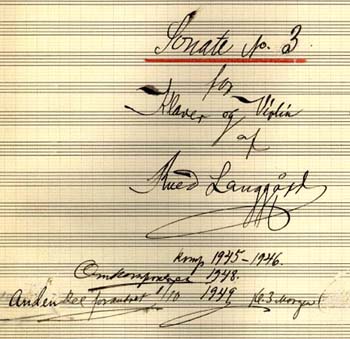In the composer's workshop
An haphazard and illogical way of working
From the middle of the 1940's, Langgaard as a rule only composed short movements, which he then later often put together to make larger compositions. These conglomerations of various pieces of music might also change over a period of several years, as new movements would be written and incorporated into already established works. In the course of this process, the composer would appear to have regarded the works as concluded after each change that he made.
An extreme example of the illogical and apparently haphazard genesis of a composition is that of Sonata No. 3 for violin and piano, the title page of which is reproduced below (as was often the case, the information given by Langgaard on the title page is misleading).

The development of this work went through 6 phases.
Originally, in 1945, it comprised only one movement (= most of the 1st Movement of the final
version).
In 1946 a second movement was added (= the 5th Movement of the final version).
In 1948 another movement was inserted (= the 3rd Movement of the final version), and later that same year
the 1st Movement was expanded by the addition of an introduction and an identical middle section. Later
in 1948 another movement was added (= the 4th Movement of the final version).
Finally, in 1949, the introduction was removed from the 1st Movement, a conclusion was added to it, and it
was incorporated into the final version as an independent 2nd Movement. This means that the
1st Movement is followed by a 2nd Movement which, apart from the conclusion, is
identical with the middle section of the 1st Movement!
![]()